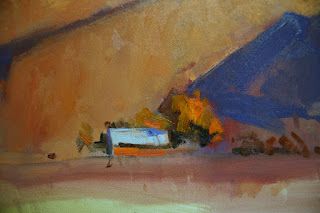
Last week I painted this scene in Big Bend. On the left bank is Mexico and on the right bank is Texas. Kind of neat when you think about it....but I digress. "Abstracting the landscape" is a common phrase thrown around in art books and workshops. I myself throw it around a lot. All it really means is if things aren't the way you like them, move them around.
When I paint plein air (outside on location) if the scene is not exactly the way I like it, I will move Mother Nature's design to get a more pleasing result in order to make a painting. This scene is one of those scenes. At the top is the scene as it exists in nature.

Here is the same scene with six areas I plan to "abstract" or move or redesign in my painting. These are the decisions I made about the scene before putting a single stroke of paint on the canvas.

"Along the Rio Grand" 9" x 12" oil/linen
1. I eliminated the second butte. By doing so I made the first butte more important to the scene and it simplified the scene.
2. I increased the size of the first butte. Again, this gives it importance.
3. I eliminated the third butte and in its place put a very distant blue hill and actually placed it behind the fourth butte giving the scene a sense of depth and distance.
4. I moved this butte towards the middle and increased its size. I wanted something between the main butte on the left and the distant hill thereby adding to the sense of depth.
5. I made this bush on the bank my focal point. I increased its size, increased the contrast in this area of the painting and dropped the river behind it to isolate it more from the rest of the painting. This gives it importance.
6. I eliminated this bank altogether.
7. And finally I designed the rocks in the foreground river so they would lead your eye to the left bank which takes you to my focal point and then down the river and out of the painting. By making the painting a vertical instead of a horizontal I am able to force the issue of a lot of depth on a small painting. I angled the row of rocks behind the focal point bush so they point down the river. In the photo they go straight across the river and I felt this would have stopped the viewer's eye movement if I painted them that way.
The nice thing about a small painting is there are fewer decisions to make. When I make this into a larger painting there will be three times as many decisions. This is one of the reasons I enjoy plein air painting so much. You get to see the result of your decisions quickly. The "abstractions" I made in this painting worked out well. The painting I did after this one ended up as two hours of total frustration and I eventually wiped it off.
One final note, I find it to be extremely important to plan my paintings, to "abstract" the scene as necessary to end up with a quality painting that engages the viewer to participate in the painting. Without the participation the viewer will dismiss the piece and move down the wall to another painting. I find it very challenging to make a powerful statement on a small painting and painting en plein air satisfies that challenge like no other form of painting.



















